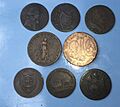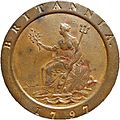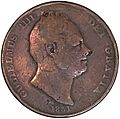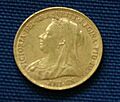History of the British penny (1714–1901) facts for kids
The penny of Great Britain and the United Kingdom changed a lot between 1714 and 1901. This was the time when the House of Hanover family ruled. The penny went from being a small silver coin that wasn't used much to the bronze coin that people today would recognize. All these coins have a picture of the monarch (king or queen) on one side. Copper and bronze pennies also show Britannia, a female figure who represents Britain, on the other side.
For most of the 1700s, the penny was a tiny silver coin. It was rarely used by ordinary people. It was mainly made for special royal gifts called Maundy money. By 1787, there wasn't enough good money in circulation. This led to many private tokens being used, including large copper coins worth one penny. In 1797, a businessman named Matthew Boulton got a contract to make official pennies at his Soho Mint in Birmingham. He made millions of them over the next ten years. After that, pennies weren't made again for general use until 1825. Copper pennies continued to be made until 1860.
By the late 1850s, the copper coins were in bad shape. Many were worn out and too big. Some were even from Boulton's time. These old coins were replaced by lighter bronze coins starting in 1860. The "Bun penny," named after Queen Victoria's hairstyle on the coin, was made from 1860 to 1894. The last years of Victoria's rule saw the "Veiled head" or "Old head" pennies. These were made from 1895 until she died in 1901.
Contents
The Silver Penny: 1700s Coins
When King George I started his rule in 1714, the English penny had been made of silver for about a thousand years. The Hanoverian kings began their reign while Sir Isaac Newton was in charge of the Royal Mint. Newton had thought about making copper pennies in 1702, but it didn't happen. At this time, silver only came to the Royal Mint in small amounts. It was often a leftover from mining other metals or from unexpected finds. For example, the South Sea Company, which had many problems, had to send a lot of silver to the Mint in 1723. But overall, very little silver was sent.
The change in kings didn't change how the silver penny looked. It was a small coin, about 12 millimeters wide and weighing 0.5 grams. George I's pennies had his name, GEORGIVS DEI GRA, on one side. The other side had MAG BR FR ET HIB REX and the date, around a crowned letter "I". The picture of George was designed by John Croker or his helper, Samuel Bull. Pennies were made in several years during George I's rule, including 1716, 1718, 1720, 1723, 1725, 1726, and 1727. The last year was when George died and his son, George II, became king.
The main reason for making silver pennies in the 1700s was for Maundy money. This was special money given out by the monarch on Maundy Thursday. Most silver pennies made after 1727 were probably used for this purpose. Enough were made for Maundy money, but not enough for everyone to use every day. Sometimes, enough coins for several years were made at once. By 1727, silver was so expensive that making pennies actually cost the Mint money. When other coins started showing George II as an older man around 1740, the penny's design stayed the same. It probably wasn't worth the effort to create a new design for such a small number of coins. Between 1727 and 1816, silver was too expensive to make many coins from it. George II's pennies had his picture facing left and his name, GEORGIVS II DEI GRATIA. The other side had MAG BRI FR ET HIB REX and the date around a crowned "I".

During the rule of King George III (1760–1820), the silver penny was still mostly used for Maundy money. Pennies similar to earlier ones, but with George III's head and his name GEORGIVS III DEI GRATIA, were made in many years. A new picture of the King was put on the penny in 1792. A third design, showing the king with a laurel wreath, was used from 1817. George III's first reverse side, used until 1780, showed the crowned "I" sticking out a lot. This was changed in 1781 so the "I" was flatter. This was probably because the outline of the "I" was showing through on the King's head on the other side of the coin. From 1817, the coin's size was made smaller, from 12 to 11 millimeters, but its weight stayed the same at 0.5 grams.
Copper Penny: 1797 to 1860
Since very little silver was made into coins in the late 1700s, smaller payments relied on copper coins. The largest copper coin before 1797 was the halfpenny. Many official halfpennies were secretly melted down, and fake, lighter ones were made from the copper. By 1787, the Mint found that only about 8% of the "halfpennies" in use were real. It was too hard to collect all the old copper coins. The government also wouldn't accept copper coins for taxes. This caused problems for small businesses that had lots of real and fake copper coins. Some parts of the country, far from London, didn't have enough copper coins. This was because new coins could only be bought at the Mint's office in London. By the late 1780s, it was hard for bosses to pay their workers.
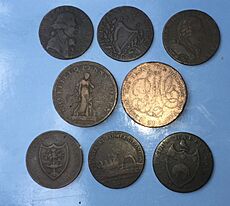
To fix this problem, private companies started making their own copper halfpenny and penny tokens in 1787. Even though they weren't official money, people used them. Many of these token makers were in Birmingham. One important person was Matthew Boulton, who made many tokens and built the Soho Mint. This was the first mint to use steam power. Boulton worked hard to get a contract to make official copper coins. In 1797, the government gave him a contract to make a huge amount of copper pennies and twopences. These were the first official British coins of these values to be made of copper. They were also the first official British coins to be made using steam power instead of human power.
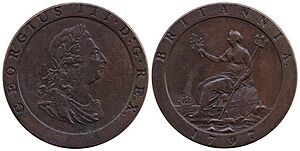
These coins were very large, with a thick edge where the words were pressed into the metal. Because of their size, they were nicknamed "cartwheels." The design was made by Boulton's employee, Conrad Küchler. The front of the cartwheel coins showed a picture of George III facing right, with the words GEORGIUS III D G REX. The back showed Britannia sitting on a rock, facing left, holding an olive branch and a trident. The words BRITANNIA 1797 were also there. Britannia had been on other coins before, but this was the first time she was shown "ruling the waves." This symbolized Britain's power at sea. The word SOHO can be seen in tiny letters on the rock below the shield. Boulton's pennies and twopences were meant to be worth their weight in copper. The penny weighed one ounce (about 28.3 grams) and was 36 millimeters wide. Boulton built a new mint at Soho to handle these large copper pieces. By 1799, each machine was making 60 pennies a minute! The amount of "cartwheels" made at Soho between 1797 and 1799 (all dated 1797) was more than all the copper coins made by the Royal Mint in the entire 1700s.
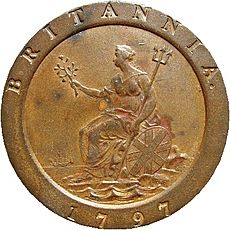
Boulton got another contract in 1799, but only halfpennies and farthings were made then. In 1805, he got another contract. By this time, the price of copper had gone up. The pennies made in 1806 and 1807 were lighter. They weighed 18.9 grams and were 34 millimeters wide. These coins had a more normal design, also by Küchler. The front showed the King facing right with the same words as the 1797 pennies. The back showed Britannia seated, holding an olive branch and trident, with the word BRITANNIA.
Official Coins: 1825 to 1860
The Mint moved to a new building in London in 1811 because its old one was too small. The new coins were made using steam power, with machines from Boulton's company. When new gold and silver coins were made starting in 1816, copper coins were not included at first. It wasn't until after George III died in 1820 and his son George IV became king that copper coins were made again. Pennies and halfpennies started being made again in 1825. George IV's pennies were only made in three years: 1825, 1826, and 1827. Most of the 1827 coins were sent to Tasmania.
The front of George IV's pennies showed his head facing left, designed by William Wyon. This was the second picture of George IV used on coins. The penny had the words GEORGIUS IV DEI GRATIA and the date. The back showed Britannia seated, facing right, with a shield and trident, and the words BRITANNIAR REX FID DEF. This penny weighed 18.8 grams and was 34 millimeters wide, just like Boulton's later pennies.
The pennies of King William IV (1830–1837) looked similar to his brother's. They were also designed by William Wyon. King William's head faced right, with the words GULIELMUS IIII DEI GRATIA. The back was the same as George IV's penny. Pennies were made in 1831, 1834, and 1837.
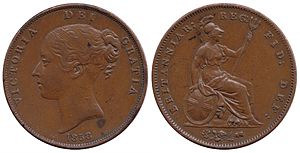
The pennies of Queen Victoria (1837–1901) have many different types. The last years of the copper penny, from 1839 to 1860, showed a picture of the Queen by William Wyon, often called the "Young Head." The back was mostly the same as King William's, but the word REX (king) was changed to REG (queen) because the ruler was now a woman. So, the words on Victorian copper pennies were VICTORIA DEI GRATIA/BRITANNIAR REG FID DEF. Copper pennies were made every year between 1839 and 1860, except for a few years. The Heaton Mint in Birmingham often supplied blank coins to the Royal Mint. Sometimes, they even made pennies themselves, though their special "H" mark didn't appear on pennies until 1874. These coins were needed for places like Ireland and the colonies.
The Bronze Penny: From 1860 Onwards
By 1857, both the Royal Mint and the public were unhappy with the copper coins. Many were worn out or had ads stamped on them. About 14% of the pennies in use were Boulton's old "cartwheels" from 1797. It was hard to tell the value of copper coins because so many different kinds were circulating. Also, all the different pennies were considered too heavy for daily use.
Thomas Graham, who was in charge of the Mint, convinced William Gladstone, the Chancellor of the Exchequer, in 1859 that the copper coins needed to be replaced with lighter, stronger ones. Bronze was chosen because it was harder and didn't rust as easily. The Mint already knew how to work with bronze because they had made bronze coins for Canada. Gladstone told the government that if you put an old penny and a new bronze penny side by side, no one would guess they were worth the same. Parliament passed a law in 1860 that allowed pennies to be made from a mix of metals. The law also said that Britannia had to stay on the coin. This was because her design symbolized Britain's power at sea. In 1860, the Mint gave a contract to James Watt & Co of Birmingham to make a huge amount of bronze pennies, halfpennies, and farthings.
Even though some people wanted a public competition, Leonard Charles Wyon, William Wyon's son, was chosen to design the new coin. Both Queen Victoria and Prince Albert were very interested in the design. Wyon had to visit them many times before Victoria approved it. There's a story that the Queen sent the final penny design back by mail, but a postman opened the package and threw the coin away when he saw it was just a penny! The new bronze coins were officially put into use on December 17, 1860. People liked them, both Wyon's designs and the fact that they were half the weight. The new coins were sent out widely through post offices. In 1861, the Mint started collecting the old copper coins. The old copper coins quickly disappeared from towns, but it took longer in the countryside. The copper pennies made before 1860 were no longer legal money after 1869 in Britain.
The front of the new penny said VICTORIA D G BRITT REG F D. The coin is called the "Bun Head penny" or "Bun penny" because of the Queen's hairstyle. The back shows Britannia, wearing robes, armor, and a helmet, holding a trident. Her right hand holds a shield with the Union Jack flag on it. A ship sails out to sea on her right, and a lighthouse is behind her on her left. The words ONE PENNY appeared on the coin for the first time.
There are many different types of Bun pennies. This is because several slightly different designs were made, and the design was changed a few times over its 35 years. An "H" below the date on some pennies (like 1874, 1875, 1876, 1881, and 1882) means the coin was made at Heaton's Mint in Birmingham. When the Royal Mint stopped making coins for a big renovation in 1882, Heaton's made a lot of pennies, halfpennies, and farthings. Bun pennies were made every year between 1860 and 1894.

A new picture of the Queen, called the "Jubilee head" by Joseph Edgar Boehm, was put on gold and silver coins in 1887. But it wasn't used for the bronze penny, which kept the Bun head. Boehm's design wasn't very popular, so in 1893, it was replaced with the "Veiled head" or "Old head" design by Thomas Brock. This new penny design started in 1895. Victoria is shown as an older woman, wearing a crown partly covered by a veil. She also wears a necklace, an earring, and a special ribbon. The words on the coin changed to VICTORIA DEI GRA BRITT REGINA FID DEF IND IMP. This was because the title of Empress of India was added to the Queen's titles in 1876. The back of the coin was also changed, with the ship and lighthouse removed. This new design was made every year from 1895 to 1901, the year Victoria died. Coins showing her and dated 1901 continued to be made until King Edward VII's coins were ready in May 1902.
Images for kids
-
Set of Maundy money from 1800, including the silver penny (top)
-
These penny (centre) and halfpenny tokens were used when there weren't enough official coins in the late 1700s and early 1800s.
-
Penny of George III, 1797. These were called "cartwheels".
-
A "cartwheel" coin from 1797, made by Boulton (this one is a twopence)
-
Penny of Queen Victoria, 1858. This was called the "Young Head".
-
Thomas Brock's "Old head" of Victoria (this is a sovereign coin)
See also
- 1844 Victoria One Penny Model





